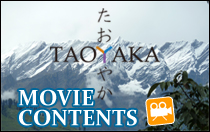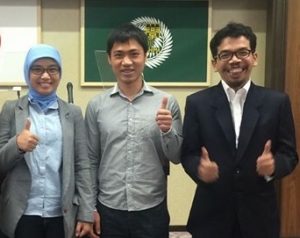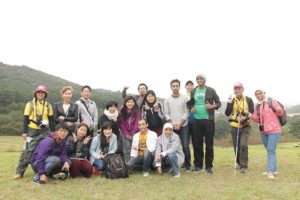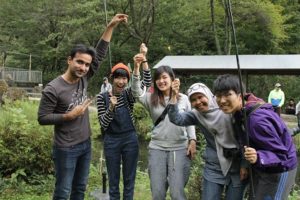Onsite Team Project : Fall-Winter 2016
From TAOYAKA Newsletter Vol.7 Summer 2017
The final stage of the onsite education. The third year (D1) of TAOYAKA Students team-up with multidisciplinary course members and challenge a real-world problem.
Revitalization of Kita Hiroshima Town by Eco-Tourism
The Team Members:
1. Novi Syaftika (D1), Graduate School for Engineering, Department of Mechanical Science and
Engineering, Technical Creation Course
2. Teguh Nur Rohman (D1), Graduate School of Biosphere Science Department of Environmental
Dynamics and Management, Technical Creation Course
3. Nguyen Thanh Quan (D1), Graduate School for International Development and Cooperation,
Program in Development Science, Social Implementation Course
We choose the location in Kita-Hiroshima, Japan to implement an onsite project with the theme of ‘Revitalization of Kita-Hiroshima Town by Eco-Tourism’. Kita- Hiroshima is famous for its beautiful nature and unique culture. Nevertheless, this town is facing a serious problem of depopulation. We believe that tourism is among the important tools for its rural revitalization. Although tourism inrural areas is not novel, the ecotourism concept is not yet popular among the local people and tourists, especially foreigners who can be the target customers.
The onsite project’s concept was developed with tourism as the focus, corresponding to the local people’s interest. As agriculture is among the major economic activities in Kita-Hiroshima, it was included to support tourism.
Rice is Kita Hiroshima’s major agricultural product, but an excessive growth of weeds problem in the paddy fields was observed, causing the decrease of soil nutrient and rice growth. We developed the new method using rice husk as an environmental friendly bioherbicide, which replaces the existing costly and harmful chemical one.
The rice production continues with the generation of rice waste, namely, rice straw and husk that are potential to be used for bioethanol production. Rice straw and husk have cellulose content, a chemical compound that can be converted into bioethanol, which can replace gasoline for various purposes, including fuelling vehicles that can be used in tourism activities. Thus, we added the energy and environment sectors.
TOURISM SECTOR: ECOHOMESTAY
We created new tourism business called Eco-homestay, with the theme of ‘inaka ine’, meaning village, nice and rice in Japanese. The participants came from different countries and backgrounds. The event held various activities, such as agricultural, cycling, fishing, hiking, cultural exchange, and visiting local companies and facilities. The concept was created and evaluated using different scenarios so that local people can continue organizing it by themselves.
AGRICULTURE
Application of rice husk in controlling paddy weeds’ Monochoria and Barnyard grass are the common weeds in the Kita- Hiroshima rice fields. These paddy weeds often inhibit the growth of rice plants by exuding endogenous toxic chemicals from the roots. Rice husk, which contains certain Eco-homestay’s poster chemical components, such as phenolic compounds and momilactones, can suppress the invasion of paddy weeds. Therefore, the role of rice husks to replace herbicide for controlling paddy weeds was studied.
The results of the laboratory experiment showed that KoshiHikari rice-husk is stronger than Akiroman and AkitaKomachi in suppressing the growth of Monochoria and Barnyard grass. Momilactones A and B were also found in KoshiHikari rice-husk, proving that these compounds are potential chemical components to develop bio-herbicide in the future.
ENERGY
About 9,000 tons and 2,000 tons of ethanol can be produced from rice straw and husks, respectively, according to our calculations of simple energy and cost analysis based on the annual production of rice in Kita Hiroshima. We selected the environmental friendly process called hydrothermal and enzymatic hydrolysis technology. The reuse of an additional chemical called catalyst, which is produced from existing biodiesel production in Oasa region, was also considered. Our laboratory experiment showed that rice straw is more potential to be used as bioethanol feedstock compare with rice husk. However, as rice harvesting is done only once a year, other agriculture waste, such as tomato residues or any other vegetable plants, could be used. A deeper feasibility study is required for a real implementation in the future.
LESSON LEARNED
This project introduced successfully a new type of tourism business in Kita-Hiroshima with the evaluation as references. The agriculture and energy sectors were laboratory experiment and desk study; however, the results can be a reference or comparison for future development. As the three sectors are related, we could not clearly measure them in our evaluation. The contribution of this project in solving the depopulation problem is indirect; hence, it could not be exhibited sharply because of the small scale and time limitation of the project. However, this project still provided a valuable lesson for all parties involved.
ACKNOWLEDGMENT
We would like to express our gratitude to NPO for collaborating with us; INE Oasa, especially Mr. Takahiro Hotta and Mrs. Asuka Toya; the Oasa Electronic Co.; Oasa Junior High School; and Prof Tsukamoto. We would also like to thank the former onsite project team (FY 2015); Mr Yamashita and Mr. Yamamoto who served as our interpreters; and Mr. Motaz Sabri who provided us with technology and media support. Finally, we would like to express our appreciation to the professors, mentors and staff of Taoyaka Program, Hiroshima University for their support.








